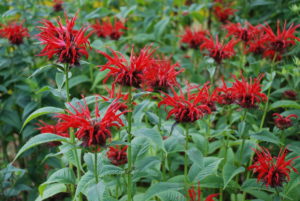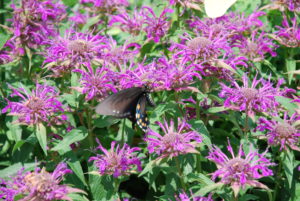Monarda, commonly known as bee balm or wild bergamot, is a popular summer flowering perennial. Their large, brightly colored flower clusters brighten the season. Flowers attract many types of wildlife, including hummingbirds, bees, butterflies, moths, and seed-eating birds. Unfortunately, many cultivars are susceptible to powdery mildew disease which causes defoliation and plant loss.
Over the past three years, MT Cuba Center in Greenville, DE evaluated the performance of 40 selections of bee balm. Staff assessed their overall garden performance in the mid-Atlantic region. Particular attention was given to plant habit, powdery mildew resistance, leaf retention, and flower coverage. There found no perfect bee balms. However, several cultivars are worth mentioning.
Monarda fistulosa ‘Claire Grace’ ranked high in the trial due to its sturdy, upright habit and prolific floral display. Compared to species, ‘Claire Grace’ has a sturdier habit, darker purple flowers, better resistance to powdery mildew, and more attractive, glossy green foliage.
Monarda ‘Dark Ponticum’ stood out in the trial for its incredibly healthy-looking foliage. The dark, bluish green leaves give the plant a very lush and attractive appearance throughout the entire season. Powdery mildew can occur but does not affect foliage health of the foliage. Violet-purple flowers attract lots of bees.
Monarda ‘Violet Queen’ is a prolific bloomer and a bee favorite. Flower color is similar, though slightly lighter than ‘Dark Ponticum’. ‘Violet Queen’ has short, silvery leaf hairs which give the leaves a dull green appearance comparable to M. fistulosa.
Monarda ‘AChall’ (Grand Marshall™) has gorgeous, deep red-purple flowers, a compact habit (28 inches tall), and excellent powdery mildew resistance. Growth habit is very uniform and plant spreads slowly.
Monarda ‘Judith’s Fancy Fuchsia’, ‘Colrain Red’, and ‘Raspberry Wine’ are all very similar in habit, flower color, and performance. Of the three, ‘Judith’s Fancy Fuchsia’ displays better disease resistance. Plants bloom 44 – 48 inch tall with abundant large, purplish red flowers in early July. Floral production is identical among all 3 cultivars, each producing 80% flower coverage at peak bloom.
Monarda ‘Purple Rooster’ has the darkest, truest purple flowers of any cultivar in the trial. Its upright, rigid stems create a strongly vertical aesthetic while the dull green leaves are highly mildew resistant and have a rough, sand-papery texture, not glossy as other beebalms.
Monarda ‘On Parade’ performs similar to the trio of purplish-red cultivars, ‘Judith’s Fancy Fuchsia’, ‘Colrain Red’, and ‘Rapsberry Wine’. All grow to about 4 feet tall with fair mildew resistance. ‘On Parade’ stands out for its brilliant, orchid purple flowers.
Monarda ‘Gardenview Scarlet’ (didyma type) is the only true red-flowering cultivar with consistent powdery mildew resistance. It has large, 4 inch wide flowers that attract lots of hummingbirds. Cultivar is similar to ‘Jacob Cline’, except it grows only 36 inches tall, almost 1 foot shorter.
Runner-up popular favorites:
‘Prairie Gypsy’
‘Jacob Cline’
‘Purple Mildew Resistant’
‘Cambridge Purple’
‘Peter’s Purple’
‘Pink Surprise’
*I encourage blog readers to read the entire Monarda Trial Report on the MT. Cuba Gardens website.



 Posted in
Posted in 
